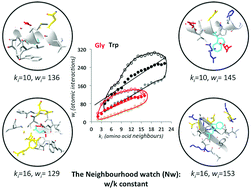In proteins, the structural responses of a position to mutation rely on the Goldilocks principle: not too many links, not too few†
Abstract
A disease has distinct genetic and molecular hallmarks such as sequence variants that are likely to produce the alternative protein structures accountable for individual responses to drugs and disease development. Thus, to set up customized therapies, the structural influences of amino acids on one another need to be tracked down. Using network-based models and classical analysis of amino acid and atomic packing in protein structures, the influence of first shell neighbors on the structural fate of a position upon mutation, is revisited. Regardless of the type and position in a structure, amino acids satisfy on average over their neighbors, a low and similar number of atomic interactions, the average called the neighborhood watch (Nw). The structural tolerance of a position to mutation depends on the modulation of the composition and/or proximity of neighbors to maintain the same Nw, before and after mutation, at every position. Changes, upon mutation of the number of atomic interactions at the level of individual pairs (wij) are structurally tolerated but influence structural dynamics. Robust, fragile and rescue interactions can be identified with Nw and wij, offering a framework to classify sequence variants according to position-dependent structural changes.



 Please wait while we load your content...
Please wait while we load your content...